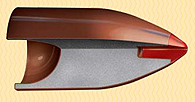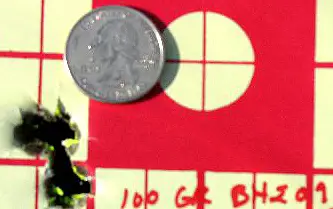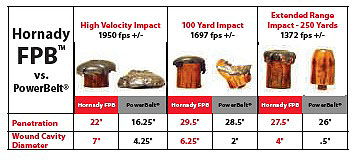Hornady�s FPB .50 Caliber Muzzleloader Bullet  Before this review even begins, I will answer the question that most muzzleloading enthusiasts would like a straight answer to: �How They Shoot in My Muzzleloader?� The best answer that can be given is you will have to try them and see. The Hornady FPB (�Flextip Projectile Blackpowder�) comes in one flavor, sized for .50 caliber and weighing 350 grains. They are supplied in packs of fifteen bullets, promising one inch groups at 100 yards, easy loading, no lube and "hard-hitting." They certainly require no lubrication, as they are jacketed bullets. As for the rest of the promises, they may or may not be true, contingent on your rifle. All rifles are individuals, of course, and there is little more individuality that can be found in today�s inline muzzleloading rifles. With a pointy nose and hollow base reminiscent of the Minie-Greener ball, it is a highly advanced treatment of this hoary design. Understanding that pure lead at high velocities may have penetration problems, this bullet is substantially tougher than pure lead. Rather than a thin �copper-wash� or copper-clad offering, this bullet is jacketed and offers the by-now proven Hornady Flex-Tip design that has proven so successful in Hornady LeverEvolution ammo. The Hornady FPB is clearly intended to compete with the popular but poor-performing �PowerBelt� line of bullets. There is little question that this new Hornady bullet is a more appropriate hunting bullet, offering better flight characteristics (Hornady�s published B. C. is .285) than any PowerBelt of similar weight. A few points should be made about bullet weight, as some folks may think that a 350 grain bullet is �heavy.� Not really, considering the caliber. Going back to the classic .45-70 Government round, the standard military carbine load was always a 405 grain bullet (SD .275) at 1305 fps. An appropriate weight for caliber is a good barometer of the bullet�s ability to penetrate: 300 grains is not at all heavy for caliber for a .45 (SD .206) and this 350 grain .50 caliber bullet is not at all heavy for a half inch bore. Hornady did a good job in selecting bullet weight, to be sure. We tested this bullet in several muzzleloaders. The Savage 10ML-II, used with Western Powders new Blackhorn 209 propellant, effortlessly turned-in tight groups at 100 yards with the FPB. However, in the T/C Triumph the bullet was hernia-class tough to load. The bullet didn�t change, of course, it was just a very tight-barreled T/C, which is not all that uncommon. Though Hornady claims 20 pounds of loading force, this cannot possibly be realistic in all barrels from all manufacturers, and we found that it was not.  One thing that this bullet dictates is proper loading, with no canting or cocking of the bullet. Loaded concentric with the bore, the slightly flared base quickly engraves and the rest of the loading is smooth and easy, or at least can be. (It was in our Savage 10ML-II.) We tried it in our Knight KP-1 where it loaded fine with no canting, but unfortunately gave us dismal accuracy compared to Barnes sabots. We had groups inside 1-1/2 inches with 250 grain Barnes TMZ sabots, but the FPB�s sprayed 4 inch groups from the same rifle. Just like .22 rimfires (or any rifle for that matter), what a given muzzleloader may like is something only your personal muzzleloader can tell you. We don�t like hearing that, but our own trigger time is going to provide the only answers that matter. �One-size fits all� does not work well in our boots or gloves and it sure doesn�t work in muzzleloaders. If one single combination always worked the best, that is what we would all be shooting. It would be nice if it was that easy, but it isn�t. The question then shifts to, "is the Hornady FPB is worth a try?" The answer to that is an unqualified �yes.� It is evident that the Hornady product is a vastly superior offering to the PowerBelt and similar projectiles. It flies better, much better, and has already been demonstrated to have better penetration vs. a PowerBelt and other conicals at virtually all ranges. The FPB is superior to PowerBelts aerodynamically and in its ability to penetrate without the �hockey puck� overexpansion of pure lead at close range. It also provides better expansion than PowerBelts at longer ranges.  This is an impressive accomplishment by Hornady. What this means to the hunter is a bullet with less drop and with more consistent terminal performance regardless of terminal impact range and velocity. Compared to the Hornady FPB, the PowerBelt is the PowerLess Belt. The groups from the Savage 10ML-II were astoundingly good, while the tight-barreled T/C Triumph's performance was equally poor. As a generality, I think that most shooters with 1:28 to 1:24 barrels of .501 in. or so land-to-land bore size will do well, assuming good barrel quality. You will certainly want to try them in your muzzleloader and decide for yourself. It also seems a clear trend that loose powder works quite a bit better with this projectile than pellets; your rifle may be the exception, of course. Congratulations to Hornady on the production of a fine new muzzleloading projectile that clearly raises the bar for bore-sized bullets by no small margin. With groups like the ones produced by the Savage, it is hard not to be impressed. |